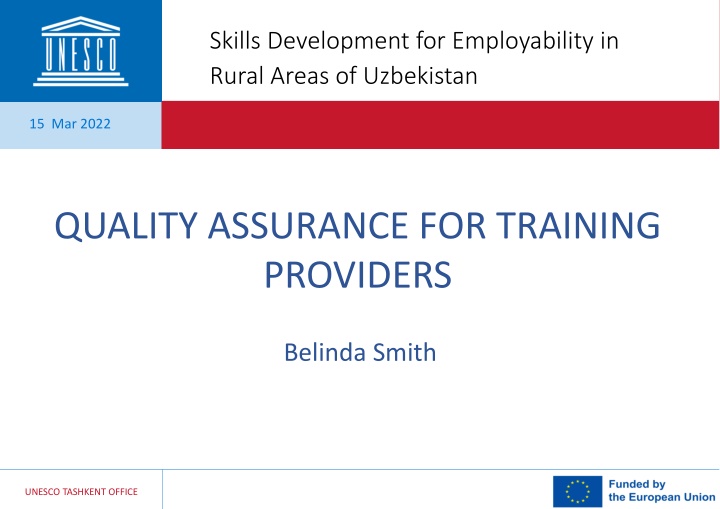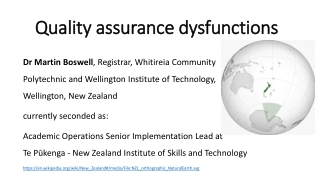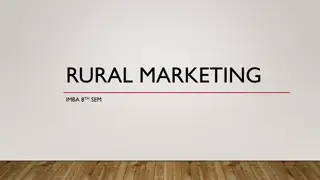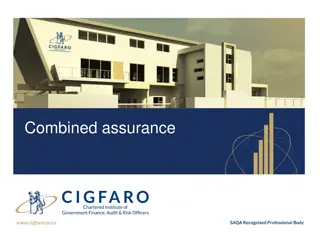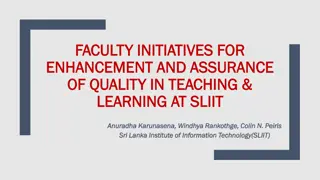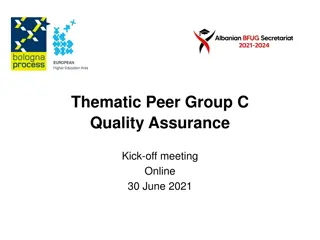Quality Assurance and Improvement Strategies in Rural Areas of Uzbekistan
Enhancing the quality of skills development for employability in rural areas of Uzbekistan requires a multi-level approach involving system, institution, and individual focus. It emphasizes evidence-based planning tied to national TVET policy objectives, stakeholder feedback, and performance evaluation. Promoting quality assurance involves engaging with industry networks, conducting skills foresight surveys, developing templates and guidelines, ensuring relevant stakeholder consultations, and verifying qualifications and assessment processes. The key lies in adopting a bottom-up and collaborative approach that recognizes the personal and organizational benefits of quality improvement.
Download Presentation

Please find below an Image/Link to download the presentation.
The content on the website is provided AS IS for your information and personal use only. It may not be sold, licensed, or shared on other websites without obtaining consent from the author.If you encounter any issues during the download, it is possible that the publisher has removed the file from their server.
You are allowed to download the files provided on this website for personal or commercial use, subject to the condition that they are used lawfully. All files are the property of their respective owners.
The content on the website is provided AS IS for your information and personal use only. It may not be sold, licensed, or shared on other websites without obtaining consent from the author.
E N D
Presentation Transcript
Skills Development for Employability in Rural Areas of Uzbekistan 15 Mar 2022 QUALITY ASSURANCE FOR TRAINING PROVIDERS Belinda Smith UNESCO TASHKENT OFFICE
What we know about why quality does and doesnt work Quality has no impact when: Top-down approach Complexity Unfamiliar processes Staff consider quality work as an extra task without any obvious benefit Lack of follow up and recognition No leadership - management commitment Quality has an impact when: A bottom up and top-down approach is used Recognition personal and organizational Staff understand and experience the benefits Involves collaborative processes UNESCO TASHKENT OFFICE 2
3 Levels of Quality Improvement System-Level Institution-Level Individual-Level Improvement System Focus Evidence based Specific local & national stakeholder feedback focus Daily work level focus Quality Improvement Planning Tied to the National TVET Policy Objectives Performance measures tied to specific local objectives & national indicators Tied to yearly individual performance Evaluation of Quality Responsiveness to national labour market needs Responsiveness to local and national labour market needs Performance of daily work Student feedback & outcomes Daily work Retention rates Student feedback & outcomes Individual performance evaluations Processes and indicators Cuts across all programs and activities Delivery of a service and meeting of outcomes Quality Improvement Goals National TVET/ Skills Policy Local level strategic plans based on the national TVET policy 3 UNESCO TASHKENT OFFICE 3
QA Qualifications Council for the Development of Professional Qualifications and Competencies SISQE Ministries SSCs Develop industry networks & ensure relevant stakeholder consultations Labour Market Observatories Skills forecast Skills foresight Surveys Develop templates, guidelines & quality processes Labour Market Skills Needs Relevant stakeholder consultations, LLL, Gender Equity & Social Inclusion Other Govt prorities Verify quality of consultations & products according to national guidelines Occupations Occupational mapping Current & Future skills Multi-method Self asses QIP Qualifications Standards Verify qualifications, learning outcomes, assessment resources meeting the industry needs Identify industry preferred assessment models Validate & verify assessment resources & processes Certification? Assessment tools Assessment models Skilled Assessors Verification Certification & Data mgt Assessment Policy Research Monitor Evaluate update UNESCO TASHKENT OFFICE 4
Registering TVET Organisations All nations have a process for gate keeping the approval or registration of training organisations. However, these processes vary in terms of: the level of scrutiny the parameters reviewed, for example program design, program materials, skills of practitioners, program facilities; and the complaints processes and outcomes of graduates. Terminology matters: registration, approval, accreditation, affiliation have different meaning in different systems. In many nations, not all training organisations require approval or registration within the TVET system. Whilst this coverage is fairly common across systems, greater variation exists in the approaches taken and the areas scrutinised for approval purposes. UNESCO TASHKENT OFFICE 5
Approaches for Training Provider QA Quality guidelines Quality Standards Self-evaluation Voluntary or not Quality Improvement Plan Approval and inspection approaches Combinations of the above Contemporary QA focuses more on quality culture, leadership, direction, action and results UNESCO TASHKENT OFFICE 6
Quality criteria for the priority component for training providers Quality Improvement Plan Report quality improvement & indicators Governance & Human Resources Management Outreach & Special Programs Do Implement improvement activities Act - Options for improvement Safe effective learning Environment infrastructure Financial stability Self evaluation Check Training Centre Industry & Stakeholder cooperation & satisfaction Curricula & Learning materials Training equipment Labs workshop Continuous & final assessment Learning Delivery Students Services UNESCO TASHKENT OFFICE 7
Processes and indicators Participation, Completion, Progression, learning strategies, relevance and flexibility, workplace Maintenance of governance, level of autonomy Continuous professional development Training Delivery Governance & HRM Attainment, Progression, Consistency in decisions, moderation activities, feedback strategies Continuous final assessments Safety & health requirements Maintenance Optimum space Environment infrastructure Progression, learning strategies, responsive to industry, flexible Stakeholder cooperation satisfaction Curricula Learning materials Employment, Satisfaction, engagement strategies Safety and health requirements Maintenance schedules Optimum space Replacement plans, currency Accountable ongoing financial viability, financial plans, meets ongoing legal requirements Equip Labs workshop Financial stability Enrolment, Participation, Employment, Dropout, Satisfaction Participation, innovation, flexibility, stakeholder involvement Students Services Outreach Special Programmes UNESCO TASHKENT OFFICE 8
QA components & process links Oversight Agency (SISQE/ Ministry Agriculture) TVET Institution Agriculture Training Centre Self evaluation Identifies readiness & evidence for audit Areas for further development Internal communication device Preparing the external audit Feeds into HO needs analysis for Continuous Prof Dev & policy implementation progress Assists in determining audit timing Quality Improvement Plan Identifies areas for focus Plan for quality improvement Tool for identifying development needs Acts as a base line for monitoring progress Reports sent to HO for monitoring Helps HO plan capacity building Incentives based on QI Feeds into risk profile Improved quality of training delivery Reports on implementation of Gov t initiatives Incentives/ Good practice Audit & monitoring Evidence in the QI Plan Assists in setting priorities Internal communication device UNESCO TASHKENT OFFICE 9
Audits Compliance approach quality standards met not met Monitoring and facilitating quality improvement - approach Performed either by the regulating body or through a third party Training of auditors Auditor moderation Many countries apply some form of risk assessment rating to minimise the audit burden but there are variations in methodologies UNESCO TASHKENT OFFICE 10
Capacity Building - Leadership is an activity not a role Training for quality champions to facilitate implementation Six one-day sessions for all staff at institutions- by quality champions Follow-up intervention for all staff at institutions- by quality champions Collaborative approaches, team building, goal setting Capacity building for management The main goals of the capacity building: Strengthening commitment to quality work (attitude change) Creating awareness regarding quality work and advantages (knowledge enhancement) Involving all staff in quality work (individual concern) Triggering quality activities in training centres (quality measures) Supporting and enhancing the introduction of QMS (quality improvement). UNESCO TASHKENT OFFICE 11
Quality Culture, Leadership, Direction, Action and Outcomes Common procedures & processes Readiness for change Focus on core procedures, processes and standardization Social committee Internal Evaluation Kick0ff Meeting Critical Friend Stakeholder feedback Teacher Competence Centralised document storage Review Reflect Reform Common Procedures Record keeping QMS Quality Committee UNESCO TASHKENT OFFICE 12
Proposed Criteria for TVET Institions 1. Governance and management of the TVET Organisation 2. Teaching and management capacity of the TVET Provider 3. Facilities and equipment of the TVET Provider 4. Management of Learning resources 5. Management of Learning Services 6. Management of Student Services 7. Data collection and communication UNESCO TASHKENT OFFICE 13
Quality criteria informationincludes: Individual criteria identifies evidence for meeting the criteria An implementation timeline 1 to 3 years Indicators ( example X@ % of teachers have received professional development on new learning methodologies) (x % per cent of graduates employed) Emphasises quality practices Peer review and critical friends UNESCO TASHKENT OFFICE 14
Next steps Continue consultations on the Quality Assurance Framework and the set of quality criteria for training providers Identifying where the different functions and responsibilities sit at the national level Review the reporting lines and governance structures for monitoring and support Capacity building for government administrators and quality championsThank you for your time Comments & Questions UNESCO TASHKENT OFFICE 15
